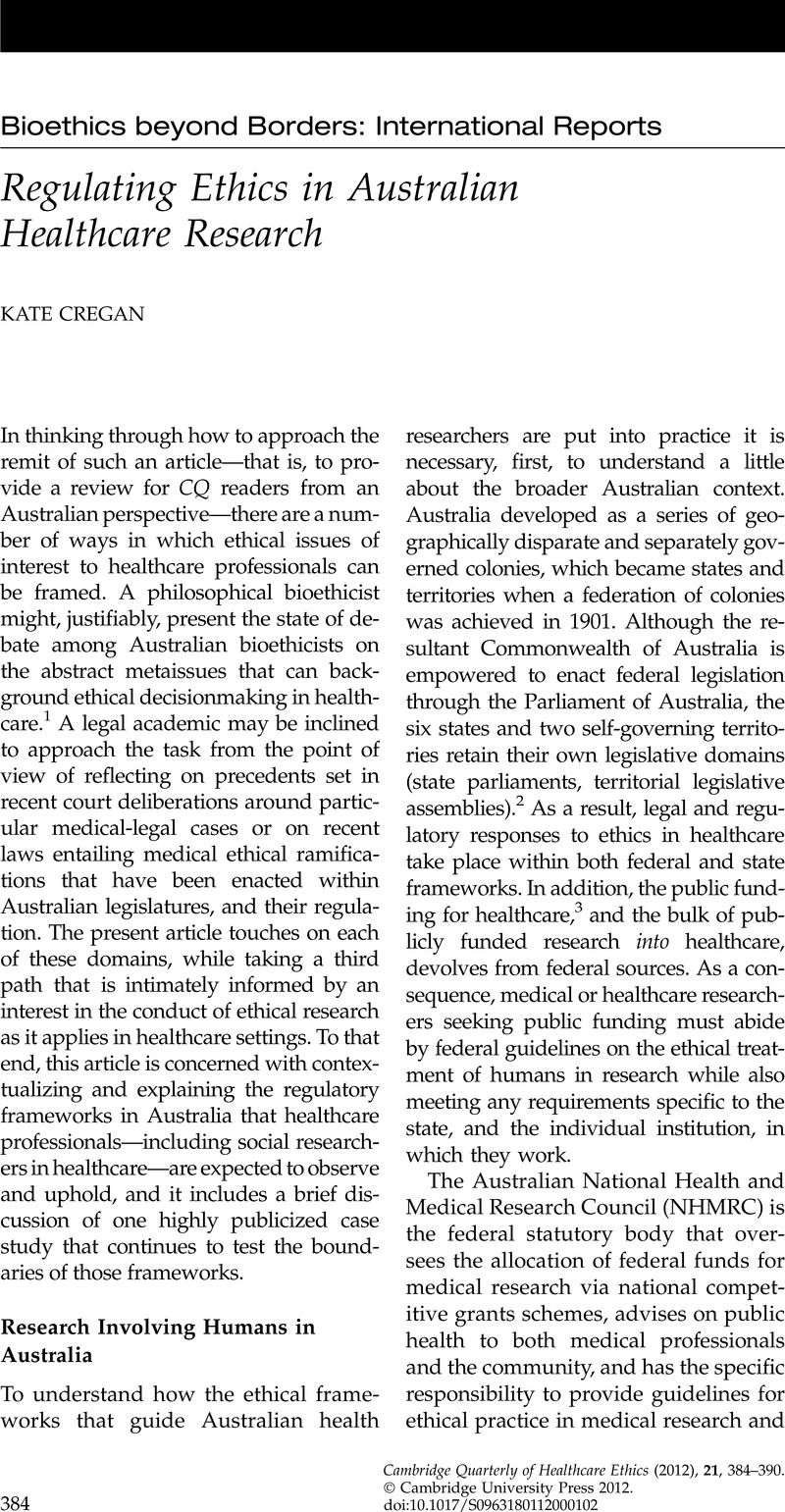Published online by Cambridge University Press: 25 May 2012

1. Australian and Australian-trained bioethicists have had significant impact on international bioethical debate. Peter Singer is perhaps the best-known Australian bioethicist, and during the 1980s and 1990s he was responsible for fostering and training a number of internationally prominent figures and for founding the Centre for Human Bioethics at Monash University.
2. States may legislate independently on subjects outside Commonwealth legislative power, but although the self-governing territories may legislate, the Commonwealth Parliament can ultimately overrule any such legislation. See also the following discussion.
3. Australia’s healthcare system sits between a fully public system such as the United Kingdom’s NHS and a privatized, insurance-driven system such as that of the United States. Australian citizens have the right to free healthcare through public hospitals, which entails waiting lists for nonemergency care, but those earning above the average wage are encouraged (through tax incentives) to take out private health insurance, to access private hospitals, and/or to pay for private beds in public hospitals.
4. National Health and Medical Research Council (NHMRC). Australian Health Ethics Committee; available athttp://www.nhmrc.gov.au/about/committees-nhmrc/australian-health-ethics-committee-ahec (last accessed 8 Oct 2011).Google Scholar
5. NHMRC. National Statement on Ethical Conduct in Human Research. Canberra: Australian Government; 2007; available athttp://www.nhmrc.gov.au/guidelines/publications/e72 (last accessed 8 Oct 2011).Google Scholar
6. See note 5, NHMRC 2007, at 69.
7. NHMRC. Values and Ethics: Guidelines for Ethical Conduct in Aboriginal and Torres Strait Islander Health Research. Canberra: Australian Government; 2003; available athttp://www.nhmrc.gov.au/guidelines/publications/e52 (last accessed 8 Oct 2011).Google Scholar
8. NHMRC. Keeping Research on Track: A Guide for Aboriginal and Torres Strait Islander Peoples about Health Research Ethics. Canberra: Australian Government; 2006; available athttp://www.nhmrc.gov.au/guidelines/publications/e65 (last accessed 8 Oct 2011).Google Scholar
9. Australian Institute of Aboriginal and Torres Strait Islander Studies (AIATSIS). Guidelines for Ethical Research in Indigenous Studies. Canberra: Australian Institute of Aboriginal and Torres Strait Islander Studies; 2011; available athttp://www.aiatsis.gov.au/research/ethical.html (last accessed 8 Oct 2011).Google Scholar
10. Public hospitals also function within state-based systems and are accountable to state governments, but the majority of funding for healthcare flows from federal sources.
11. The most recent report cites 221 HRECs across the six states and two territories; see NHMRC. Report on the Activity of NHMRC-Registered HRECs for the Period 1 January 2009–31 December 2009. Canberra: Australian Government; 2010; available athttp://www.nhmrc.gov.au/_files_nhmrc/file/health_ethics/hrecs/hrec_report_2009.pdf (last accessed 8 Oct 2011). However, the number fluctuates with institutional reorganizations, as previous reports show (e.g., there were 232 in 2008 and 226 in 2007).Google Scholar
12. Herbert, D.A study into the social and ethical dimensions of genetic testing in the haemophilia community [dissertation]. Monash University; 2011.Google Scholar
13. Herbert, D.The social sciences and human research ethics committees [presentation]. CEMS Student Writing Workshop; 2011 Sept 24; Monash University (in preparation for publication).Google Scholar
14. For federal-based responses see National Ethics Application Form; available at https://www.neaf.gov.au/Default.aspx. For state-based responses see, e.g., State Government of Victoria, Australia, Department of Human Services. Victorian Government Health Information; available at http://www.health.vic.gov.au/ethics/single/neaf_vsm.htm (last accessed 8 Oct 2011).
15. See note 5, NHMRC 2007, at 13.
16. Wild, R, Anderson, P. Ampe Akelyernemane Meke Mekarle: “Little Children are Sacred.” Report of the Northern Territory Board of Inquiry into the Protection of Aboriginal Children from Sexual Abuse. Darwin: Northern Territory Government; 2007; available athttp://www.inquirysaac.nt.gov.au/pdf/bipacsa_final_report.pdf (last accessed 8 Oct 2011).Google Scholar
17. It was necessary for the federal government to suspend federal antiracist legislation, namely the Racial Discrimination Act (1975), in order to proceed, as there were clear conflicts between the act and the actions of the Intervention.